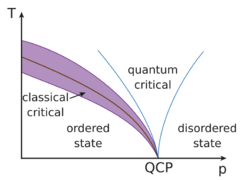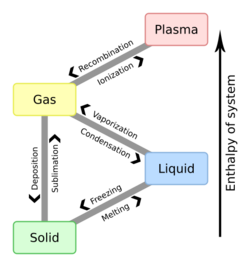Physics:Supersolid
| Condensed matter physics |
|---|
 |
| Phases · Phase transition · QCP |
In condensed matter physics, a supersolid is a spatially ordered material with superfluid properties. In the case of helium-4, it has been conjectured since the 1960s that it might be possible to create a supersolid.[1] Starting from 2017, a definitive proof for the existence of this state was provided by several experiments using atomic Bose–Einstein condensates.[2] The general conditions required for supersolidity to emerge in a certain substance are a topic of ongoing research.
Background
A supersolid is a special quantum state of matter where particles form a rigid, spatially ordered structure, but also flow with zero viscosity. This is in contradiction to the intuition that flow, and in particular superfluid flow with zero viscosity, is a property exclusive to the fluid state, e.g., superconducting electron and neutron fluids, gases with Bose–Einstein condensates, or unconventional liquids such as helium-4 or helium-3 at sufficiently low temperature. For more than 50 years it was thus unclear whether the supersolid state can exist.[3]
Experiments using helium
While several experiments yielded negative results, in the 1980s, John Goodkind discovered the first anomaly in a solid by using ultrasound.[4] Inspired by his observation, in 2004 Eun-Seong Kim and Moses Chan at Pennsylvania State University saw phenomena which were interpreted as supersolid behavior.[5] Specifically, they observed a non-classical rotational moment of inertia[6] of a torsional oscillator. This observation could not be explained by classical models but was consistent with superfluid-like behavior of a small percentage of the helium atoms contained within the oscillator.
This observation triggered a large number of follow-up studies to reveal the role played by crystal defects or helium-3 impurities. Further experimentation has cast some doubt on the existence of a true supersolid in helium. Most importantly, it was shown that the observed phenomena could be largely explained due to changes in the elastic properties of the helium.[7] In 2012, Chan repeated his original experiments with a new apparatus that was designed to eliminate any such contributions. In this experiment, Chan and his coauthors found no evidence of supersolidity.[8]
Experiments using ultracold quantum gases
In 2017, two research groups from ETH Zurich and from MIT reported on the creation of an ultracold quantum gas with supersolid properties. The Zurich group placed a Bose–Einstein condensate inside two optical resonators, which enhanced the atomic interactions until they started to spontaneously crystallize and form a solid that maintains the inherent superfluidity of Bose–Einstein condensates.[9][10] This setting realises a special form of a supersolid, the so-called lattice supersolid, where atoms are pinned to the sites of an externally imposed lattice structure. The MIT group exposed a Bose–Einstein condensate in a double-well potential to light beams that created an effective spin–orbit coupling. The interference between the atoms on the two spin–orbit coupled lattice sites gave rise to a characteristic density modulation.[11][12]
In 2019, three groups from Stuttgart, Florence, and Innsbruck observed supersolid properties in dipolar Bose–Einstein condensates[13] formed from lanthanide atoms. In these systems, supersolidity emerges directly from the atomic interactions, without the need for an external optical lattice. This facilitated also the direct observation of superfluid flow and hence the definitive proof for the existence of the supersolid state of matter.[14][15]
In 2021, dysprosium was used to create a 2-dimensional supersolid quantum gas.[16] In 2022, the same team created a supersolid disk in a round trap.[17]
In 2021, confocal cavity quantum electrodynamics with a Bose–Einstein condensate was used to create a supersolid that possesses a key property of solids, vibration. That is, a supersolid was created that possesses lattice phonons with a Goldstone mode dispersion exhibiting a 16 cm/s speed of sound.[18]
Theory
In most theories of this state, it is supposed that vacancies – empty sites normally occupied by particles in an ideal crystal – lead to supersolidity. These vacancies are caused by zero-point energy, which also causes them to move from site to site as waves. Because vacancies are bosons, if such clouds of vacancies can exist at very low temperatures, then a Bose–Einstein condensation of vacancies could occur at temperatures less than a few tenths of a Kelvin. A coherent flow of vacancies is equivalent to a "superflow" (frictionless flow) of particles in the opposite direction. Despite the presence of the gas of vacancies, the ordered structure of a crystal is maintained, although with less than one particle on each lattice site on average. Alternatively, a supersolid can also emerge from a superfluid. In this situation, which is realised in the experiments with atomic Bose–Einstein condensates, the spatially ordered structure is a modulation on top of the superfluid density distribution.
See also
References
- ↑ Chester, G. V. (1970). "Speculations on Bose–Einstein Condensation and Quantum Crystals". Physical Review A 2 (1): 256–258. doi:10.1103/PhysRevA.2.256. Bibcode: 1970PhRvA...2..256C.
- ↑ Donner, Tobias (2019-04-03). "Viewpoint: Dipolar Quantum Gases go Supersolid". Physics 12: 38. doi:10.1103/Physics.12.38.
- ↑ Balibar, Sebastien (March 2010). "The enigma of supersolidity". Nature 464 (7286): 176–182. doi:10.1038/nature08913. PMID 20220834. Bibcode: 2010Natur.464..176B.
- ↑ Chalmers, Matthew (2007-05-01). "The quantum solid that defies expectation". Physics World. http://physicsworld.com/cws/article/print/27733.
- ↑ Kim, E.; Chan, M. H. W. (2004). "Probable Observation of a Supersolid Helium Phase". Nature 427 (6971): 225–227. doi:10.1038/nature02220. PMID 14724632. Bibcode: 2004Natur.427..225K.
- ↑ Leggett, A. J. (1970-11-30). "Can a Solid Be "Superfluid"?". Physical Review Letters 25 (22): 1543–1546. doi:10.1103/PhysRevLett.25.1543. Bibcode: 1970PhRvL..25.1543L.
- ↑ Day, James; Beamish, John (December 2007). "Low-temperature shear modulus changes in solid 4 He and connection to supersolidity". Nature 450 (7171): 853–856. doi:10.1038/nature06383. PMID 18064007. Bibcode: 2007Natur.450..853D.
- ↑ Voss, David (2012-10-08). "Focus: Supersolid Discoverer's New Experiments Show No Supersolid". Physics 5: 111. doi:10.1103/physics.5.111. Bibcode: 2012PhyOJ...5..111V.
- ↑ Würsten, Felix (1 March 2017). "Crystalline and liquid at the same time". ETH Zurich. https://www.ethz.ch/content/main/en/news-und-veranstaltungen/eth-news/news/2017/03/Kristallin-und-fluessig-zugleich.html.
- ↑ Léonard, Julian; Morales, Andrea; Zupancic, Philip; Esslinger, Tilman; Donner, Tobias (1 March 2017). "Supersolid formation in a quantum gas breaking a continuous translational symmetry". Nature 543 (7643): 87–90. doi:10.1038/nature21067. PMID 28252072. Bibcode: 2017Natur.543...87L.
- ↑ Keller, Julia C. (March 2, 2017). "MIT researchers create new form of matter". MIT News. https://news.mit.edu/2017/mit-researchers-create-new-form-matter-0302.
- ↑ Li, Jun-Ru; Lee, Jeongwon; Huang, Wujie; Burchesky, Sean; Shteynas, Boris; Top, Furkan Çağrı; Jamison, Alan O.; Ketterle, Wolfgang (1 March 2017). "A stripe phase with supersolid properties in spin–orbit-coupled Bose–Einstein condensates". Nature 543 (7643): 91–94. doi:10.1038/nature21431. PMID 28252062. Bibcode: 2017Natur.543...91L.
- ↑ Donner, Tobias (April 3, 2019). "Viewpoint: Dipolar Quantum Gases go Supersolid". APS Physics. http://physics.aps.org/articles/v12/38.
- ↑ Guo, Mingyang; Böttcher, Fabian; Hertkorn, Jens; Schmidt, Jan-Niklas; Wenzel, Matthias; Büchler, Hans Peter; Langen, Tim; Pfau, Tilman (October 2019). "The low-energy Goldstone mode in a trapped dipolar supersolid". Nature 574 (7778): 386–389. doi:10.1038/s41586-019-1569-5. PMID 31499511. Bibcode: 2019Natur.574..386G.
- ↑ Tanzi, L.; Roccuzzo, S. M.; Lucioni, E.; Famà, F.; Fioretti, A.; Gabbanini, C.; Modugno, G.; Recati, A. et al. (October 2019). "Supersolid symmetry breaking from compressional oscillations in a dipolar quantum gas". Nature 574 (7778): 382–385. doi:10.1038/s41586-019-1568-6. PMID 31499510. Bibcode: 2019Natur.574..382T.
- ↑ Norcia, Matthew A.; Politi, Claudia; Klaus, Lauritz; Poli, Elena; Sohmen, Maximilian; Mark, Manfred J.; Bisset, Russell N.; Santos, Luis et al. (August 2021). "Two-dimensional supersolidity in a dipolar quantum gas". Nature 596 (7872): 357–361. doi:10.1038/s41586-021-03725-7. PMID 34408330. Bibcode: 2021Natur.596..357N.
- ↑ Bland, Thomas; Poli, Elena; Politi, Claudia; Lauritz, Klaus; Norcia, Matthew A.; Ferlaino, Francesca; Santos, Luis; Bisset, Russell N. (13 May 2022). "Two-dimensional supersolidity in a circular trap". Phys. Rev. Lett. 128 (19): 195302. doi:10.1103/PhysRevLett.128.195302. PMID 35622047.
- ↑ Guo, Yudan; Kroeze, Ronen M.; Marsh, Brendan P.; Gopalakrishnan, Sarang; Keeling, Jonathan; Lev, Benjamin L. (2021). "An optical lattice with sound". Nature 599 (7884): 211–215. doi:10.1038/s41586-021-03945-x. PMID 34759361. Bibcode: 2021Natur.599..211G.
External links
- Nature story on a supersolid experiment
- APS Physics Magazine on a vibrating supersolid experiment
- Penn State: What is a Supersolid?
- "Supersolid behaviour spotted in dipolar quantum gases". 20 April 2019. https://physicsworld.com/a/supersolid-behaviour-spotted-in-dipolar-quantum-gases/.
 |


